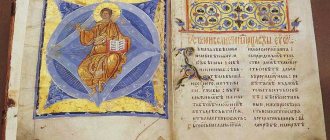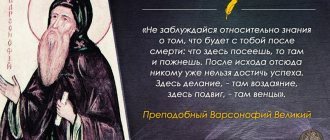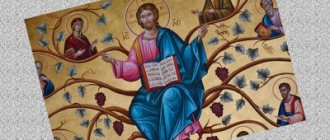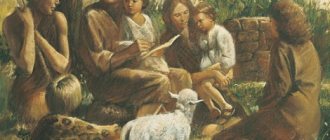Latin Bible copied by hand in 1407 AD.
e. Bible
(from the Greek βιβλία - books, singular βιβλίον, diminutive of βίβλος - book) - a collection of ancient texts created in the Middle East over the course of 15 centuries (XIII century BC - II century AD. ). It is the Holy Scripture for all Abrahamic religions - Judaism, Christianity and Islam, but it is canonized only in the first two named.
The Bible is the only true source that sufficiently reveals the essence of God, shows God's relationship to man and explains how man can gain fellowship with the Creator.
Book of Divine Origin
When getting acquainted with any book, you want to know who its author is, its contents and the total volume of the work. This is what happens with the Bible. Having picked up a hefty volume of the Synodal publication for the first time, a person naturally wants to ask various questions. Who wrote it? What does it say? How many pages and chapters are there in the Bible?
Many people have a Bible at home, but not everyone reads it. This can be explained by the lack of an adequate understanding of what this Book is. Let's try to figure this out.
The Bible in Orthodox worship
Bible: General Information
In the Old Testament era, the Hebrew word “mikra” (“מקרא”, literally translated as “reading”) was used to designate sacred texts. In Greek, the designation for the body of sacred texts is “Bible” (“τὰ βιβλία”). In early Christian times, the entire complex of Holy Scripture (Old and New Testaments) received this name. The division of the Bible into two Testaments is associated with the Incarnation of the Son of God. Before His Nativity - the Old Testament, after Christmas - the New Testament.
The Bible included books of varied content, written in different eras in different literary styles and genres. They were written over a long period, more than a thousand years. The authorship of these Books belongs to completely different people: shepherds, fishermen, priests, kings, scribes. In addition, they all wrote in different languages: Hebrew, Aramaic, Greek. But despite all this, the Bible is a single whole. None of the books contradict each other. All of them complement the teaching about the true Creator of the world.
“A very remarkable fact that is worth paying special attention to is that Christ did not write anything Himself... And the essence of Christianity is not in scripture, not in books and teachings. It is in the incarnation of the Son of God and thereby the salvation of people. Christ is not only and not so much a Teacher as the Savior of mankind. This is the fundamental difference between Christianity and other religions.
For example, for Muslims, the Word of God embodied in the world is a book, the Koran. Islam believes that the Koran existed before the creation of the world and that it was literally dictated word for word by Allah to the Prophet Mohammed. In Christianity, the Word of God is Christ himself. And the Bible, “Books,” only speak about Him, first foreshadowing His coming in the Old Testament, then directly telling in the New Testament about His earthly life, miracles, suffering, death and Resurrection” (candidate of philosophical sciences Yuri Pushchaev).
Gospels
The first three gospels, similar to each other (Matthew, Mark and Luke), describing the earthly life of Jesus Christ in sequential order, contain many parallel passages. In the 18th century, they were published in the form of a Synopsis (i.e., in parallel columns) and received the general name synoptic (Greek “zuporzgs” - “review”). In fact, this is one gospel, presented in three versions - one short (from Mark) and two lengthy ones. The Gospel of John the Theologian is often called “spiritual”, since this text is devoted not so much to presentation as to the understanding of sacred events.
Matthew and Luke introduce the story with the genealogy of Joseph the Betrothed, in which the central figure is occupied by the figure of King David, the founder of the royal dynasty. According to Matthew, David is separated from Jesus by 28 generations, in Luke this number is 43; There are also discrepancies in the names of the ancestors given by each of the evangelists. For all weather forecasters, the place where the events take place is Palestine, the time is the 1st century, and Jesus is the long-awaited messiah, a descendant of the king of the Jews.
For John, the time of action is eternity, and the place is the universe. And Christ, sent into the world, is Light, Truth, the Word of the Father. The Prologue of the Gospel is sharply polemical in relation to the Old Testament Shestodnev. The book of Genesis opens with the words: “In the beginning God created the heavens and the earth” (that is, the material world); John says: “In the beginning was the Word, and the Word was with God, and the Word was God.”
Jesus Christ of John is majestic - he is the Heavenly King who came to people to establish a new Law. He ends his earthly journey not with a desperate cry: “Father, why have you forsaken Me?”, but with a triumphant affirmation: “It is finished!”
None of the evangelists, except John, have a direct contrast between the Heavenly Father and the deity of the Jerusalem temple: “I say what I saw with my Father; but you do what you saw your father do... If God were your father, then you would love me...” (John 8: 38-42); “Your father is the devil, and you want to do the lusts of your father; he was a murderer from the beginning and did not stand in the truth, for there is no truth in him” (John 8:44).
Researchers have noted numerous contradictions within each of the Gospels, for example:
in the Sermon on the Mount, Christ contrasts the norms of the new ethics with the establishment of the Jewish Law (Matthew, chapter 5), and here a clear indication is given that one should not deviate one iota from the Law (Matthew, 5: 18);
the idea of salvation only for the Jews (“I was sent only to the lost sheep of the house of Israel,” Matt. 15:24, etc.) is contradicted by the equally categorical statement that the Kingdom of God will be taken away from them and given to another people (Matt. 21 : 43);
John repeatedly expressed the conviction that the Jews do not know God (“But you have never heard His voice, nor seen His face, and you do not have His words abiding in you...”, John 5: 37; “And you have not knew Him, and I know Him,” John 8:55, etc.) and at the same time it is directly stated that “salvation comes from the Jews” (John 4:22).
Many speculations have been made regarding such contradictions. A number of researchers connect the ideological diversity of the canonical texts with the political situation that developed after the defeat of the anti-Roman uprising (132-135), when some Jews, in search of new life guidelines, came to the Christian church. It is believed that this circumstance led to the drift of Christian doctrine from the original anti-Judaism to relative reconciliation and partial merging with the Jewish tradition (which manifested itself in tendentious editorial editing of the source texts, connecting the actions of the Savior with “what was spoken through the prophets”).
The search for the “true” (intact) canon constitutes one of the important areas of Protestant biblical scholarship; This is partly due to the fact that for Protestant theology, Holy Scripture constitutes the only source of truth and faith. Domestic researchers also speak about a certain gap between church orthodoxy and the original dogma.
How many pages are in the Bible
But still, how many pages are there in the Bible? It is impossible to give a single exact answer to how many pages there are in the Bible. Like any printed publication, the Bible can come in different formats. Depending on the publisher, the amount of text on one page can vary significantly. Accordingly, one Bible may have, relatively speaking, 300 pages, and another 1000 pages. However, their content will be identical.
For example, the famous Kennicott Bible (15th century, Spain) has 922 pages. The Bible of the Synodal edition has 1217 pages. A more correct question would be not about the number of pages, but about the number of books that make up the Bible.
Initially, each Book (77 in total) was represented by a separate scroll. During the period of the spread of Christianity, it was decided to unite them into one complete assembly. The central plot of the biblical narrative is the story of the Lord's salvation of humanity, which found itself under the power of sin and death after the first people retreated from the commands of the Creator.
It became possible to combine the Books into one collection not only because they all had a common theme. To write the sacred Books, their authors received God's inspiration.
“If a brilliant poet is inspired by a muse, then those who wrote the Bible were inspired by God Himself. The Holy Spirit dwelt in the heart of each of them, which is why biblical authors are often called prophets. As befits prophets, they possessed supernatural gifts. The Lord revealed to them what was hidden from the eyes of other people, helped them to see this world and everything that happens in it through His eyes. The task of the prophet was to express this revelation with the help of human concepts and words in suitable images and appropriate literary form” (priest Dmitry Baritsky).
Structure of the Bible
What does the Bible consist of? The Holy Scriptures are divided into two sections: the Old and New Testaments.
The creation of the Books of the Old Testament dates back to the time before the appearance of the Son of God in the world. Their main goal was to prepare the chosen people of Israel for the coming of the Savior. They recalled the Covenant (agreement) concluded with God, the meaning of which was to preserve the chosen people from spiritual destruction. The Jews were threatened with falling into paganism and the final loss of contact with the True God.
The books of the New Testament tell about the earthly life of the God-man and describe His teaching. The Epistles of the Apostles contain instructions for achieving the salvation of the soul. Divine Revelation lifts the curtain on the last times. The conclusion of the New Testament testifies to a new qualitative relationship between God and man.
The Savior's death on the cross redeemed man from original sin and its consequences. A believer in the True God acquires the state of sonship, which gives new strength for salvation. Now a person can relate to the Creator not as a humble servant to a stern Master, but as a child to a loving Father. The main Christian prayer testifies to this. In it, believers address God “Our Father,” that is, “Our Father.”
Inerrancy
The Bible is inerrant, that is, it contains reliable information, has no scientific or historical errors, and infallibly fulfills its purpose: it leads a person to personal communication with God.
| The law of the Lord is perfect, strengthens the soul; the revelation of the Lord is faithful, making wise the simple; the commandments of the Lord are righteous and gladden the heart; The commandment of the Lord is bright, it enlightens the eyes (Ps. 19:8-9) |
| He who has My commandments and keeps them, he loves Me; and whoever loves Me will be loved by My Father; and I will love him and show myself to him (John 14:21) |
Copies and translations of the Bible are inspired, but only to the extent that they preserve the message of the original text.
Books of the Old Testament
The largest part of the Bible consists of the books of the Old Testament. Different Christian denominations recognize from 39 to 50 Old Testament books as sacred. It is generally accepted to divide them conditionally depending on their content. This division has nothing to do with how many pages there are in the Bible.
The first five books (Genesis, Exodus, Leviticus, Numbers, Deuteronomy) are considered positive. They contain stories about the creation of the world and people, the history of receiving God's Law.
12 Books (two books of Chronicles, first book of Ezra, Nehemiah, Esther, Joshua, Judges of Israel, Ruth, four books of Kings) describe the history of the Israeli people before the Coming of the Son of God into the world.
The teaching books include five books: Ecclesiastes, Song of Songs, Job, Psalms, Proverbs of Solomon. They instruct to observe piety and righteousness, to preserve wisdom and love, to honor the Lord and follow His Will.
17 Books contain prophecies. They are named after their authors, the prophets: Isaiah, Habakkuk, Zephaniah, Haggai, Zechariah, Malachi, Jeremiah, Amos, Obadiah, Jonah, Micah, Nahum, Lamentations, Ezekiel, Daniel, Hosea, Joel.
11 Books (3 Books of Maccabees, Epistle of Jeremiah, Wisdom of Solomon, Baruch, Wisdom of Jesus son of Sirach, Tobit, second and third Books of Ezra, Judith) are recognized as deuterocanonical. These books were also written in antiquity (after the 4th century BC) in Hebrew and Greek. However, the Church does not recognize them as inspired books. Therefore, the texts of these particular books are not used in Orthodox worship. But they were left in the lists among other Old Testament books. Their purpose is edifying home reading, as they contain high moral teaching.
Translations
By the end of the 1st millennium BC. e. Many Jews who settled in the countries of the Eastern Mediterranean began to forget the language of the Torah - Hebrew. Under these conditions, the need arose to translate the Holy Scriptures into Greek. (according to legend, the Tanakh (Old Testament, in the Christian tradition) was translated by seventy “interpreters” of Egypt and therefore received the name Septuagint. Quotations from the Old Testament accompanying the New Testament texts are given from this source.
The Septuagint contained 11 more books than the Hebrew codex; at the same time, the texts of some canonical books were supplemented with Greek inserts. These 11 books in Orthodoxy are considered “spiritual”, but not inspired, in Catholicism they are recognized as deuterocanonical sources (Tobit, Judith, Wisdom of Solomon, etc.).
In 382, Jerome of Stridon, based on the Septuagint, translated the Bible into Latin; the translation was called the Vulgate (vulgatus means “widespread, generally known”). For several centuries, the use of the Bible in Catholic countries of Europe was limited to the Vulgate.
Reformers defended the right of believers to study the Bible in national languages. In 1380, Oxford professor John Wycliffe translated the Vulgate into English. 30 years after the death of the professor, the Council of Constance (1415) recognized him as a heretic; The rebel's decayed bones were dug out of the grave, burned and thrown into the river.
Severe punishment also awaited the followers of the “first Protestant”, who were burned at the stake along with the translated Bible.
At the beginning of the 16th century, Martin Luther, the main ideologist of the Reformation, translated the Bible into German. With the victory of Protestantism in Germany, Lutherans were able to read the Bible in their native language without risking their lives.
Today the Bible has been translated into almost all languages of the world.
Books of the New Testament
The New Testament consists of 27 Books.
4 Gospels - Matthew, Mark, Luke, John - tell about the life of the Savior on earth, about His acceptance of death on the Cross, about the Resurrection from the dead. They reveal the teaching of Christ about the necessity and conditions for the salvation of every human soul.
The Book of Acts of the Holy Apostles is historical. It tells the story of the birth of the Christian Church and the spread of the Christian faith.
Twenty-one Books contain the teachings of the apostles about the Lord, about the life of the Christian Church, and instructions on what true faith should be. These are the Epistles of the Apostle Paul to the Corinthians (two), Galatians, Ephesians, Romans, Philippians, Colossians, Thessalonians (two), Hebrews, Timothy (two), Titus, Philemon, the Epistle of the Apostle James, two Epistles of the Apostle Peter, three Epistles of the Apostle John , Epistle of the Apostle Jude.
The Book of Revelations of John the Theologian has a prophetic character. This Book speaks of the coming, last times. It is written in allegorical language, so the visions described in it do not have a clear and unambiguous interpretation. Everything will be clarified in the future, when the times described come.
Heretic
Two swords cannot be sheathed.
Persian proverb
Around 140, the wealthy shipowner and prominent early church figure Marcion (later declared a heretic) published the Gospel of Luke and the 10 epistles of the Apostle Paul, collected during his voyages in the Mediterranean. Soon after this, the elders of the Roman community, without leaving Rome, miraculously found an “even more authentic” version of the epistles, and then “pastoral” texts (epistles to Timothy and Titus), which obviously had nothing to do with Paul.
Marcion's text was significantly shorter than the "more authentic" one, and the dissident theologian was accused of shortening the original version to suit his heretical views. Theologians copiously quoted the disgraced publication, which allowed A. von Harnack to restore a significant part of it. The French researcher P. L. Couchoux, having compared the reconstruction with the canon, came to the conclusion that Marcion's version is original and genuine, while the canonical messages include numerous insertions and alterations, sometimes completely destroying Paul's thought. Already the author of 2 Peter points out “something difficult to understand” in the letters of Paul (2 Peter 3:15), and the late antique publicist Porphyry directly reproaches the apostle for constantly contradicting himself.
At the time of the conflict, part of the Roman clergy adhered to the monarchist doctrine, identifying Christ with the deity of the Jerusalem temple (bishops Victor, Zephyrinus and Callistus, who led the Roman community after the expulsion of Marcion, went down in history as monarchians). Marcion, in his writings, rejects the version of the doctrine that leads “under the name of our Lord Jesus Christ” to the “Law and circumcision.” From Marcion's point of view, scripture must be taken literally; to confirm its truth, no philosophical justifications and no external authorities are needed, especially the authority of the Old Testament.
Contrasting Yahweh and the gospel God the Father, Marcion writes: “The first promises earth as a reward, the second heaven. The first prescribes circumcision and the killing of the conquered, while the second prohibits both. The first curses the earth, and the second blesses it... The first prescribes revenge, the second - forgiveness of those who repent... The first promises the Jews dominion over the world, and the second prohibits dominion over others... In the Old Testament - the unbearable yoke of the law, and in the New - the good and light burden of Christ " . “No theodicy, no theological cosmology! Nothing but love! - this is how A. von Harnack defines the essence of Marcion’s sermon.
Who wrote the Bible and when?
Believers consider God himself to be the author of the Bible. Accordingly, the people who wrote the Divine Revelation act as intermediaries, transmitters of the Highest Wisdom.
“The Bible is often called the Word of God because it records what God Himself told people. He spoke to all humanity through selected, religiously gifted people capable of hearing God's voice. The books included in the Bible were written by different people, at different times, even in different centuries. At the same time, God Himself is recognized as the author of the Bible. The book of books was written not without God, but also not without people who are devoted to God, who love God, who know Him with their minds and hearts. We see this from the fact that God revealed himself to them. Therefore, our Bible is a revelation - a revelation of God" (Archpriest Georgy Sidorenko)
The Prophet Moses wrote down the Pentateuch (Book of Deuteronomy, 31:8). The Prophet Moses lived in the 15th century BC (1 Book of Kings, 6:1).
The author of the Book of Job is not known with certainty. Professor Pavel Aleksandrovich Yungerov (1856-1921) believed that this Book was written before the Babylonian captivity (6th century BC). Currently, the prevailing opinion is that of Bishop of Riga Filaret Filaretov (1824-1882). He attributed the book of Job to the Second Temple period (538-70 BC). Bishop Philaret called it the very last work of Old Testament times.
Books about the lives of King David and King Solomon date back to the 10th century BC.
In the 8th-5th centuries BC the Books of the Prophets were written. The names of the authors are contained in the very titles of these Books.
The authors of the Books of the New Testament (1st century) are the apostles of Jesus Christ.
It is believed that the canon of Old Testament books was formed in the Maccabean period (2nd century BC).
The books of the New Testament were recognized as canonical by the Ecumenical Councils. The question of the New Testament canon was discussed at the local councils of Hippo (393) and Carthage (419). The texts of the New Testament were finally approved as canonical by the second rule of the Council of Trullo (692). Many early works on Christian themes were considered apocryphal and did not correspond to church canons).
Holy Bible
So that the Revelation given by God was unchanging, accurate and could be passed on from generation to generation (from generation to generation), the Lord gave people the Holy Scriptures . God revealed Himself and His will through the prophets. He commanded them to write down everything that He proclaims to the representatives of the chosen people: Now go, write it on their board, and write it in a book, so that it will remain for the future, forever, forever (Is 30:8).
The Bible consists of the sacred books of the Old and New Testaments , which contain Divine revelation about God, the world and our salvation. Through them, God gradually (as humanity matured spiritually) revealed truths. The greatest of them is about the Savior of the world. Jesus Christ is the spiritual heart of the Bible. His incarnation, death on the cross for our sins and resurrection are the main events of not only Sacred, but world history. Jesus Christ spiritually unites both Testaments. The Old Testament speaks of His expectation, and the New Testament speaks of the fulfillment of this expectation. The Savior said to the Jews: Search the Scriptures, for through them you think you have eternal life; and they testify of Me (John 5:39).
The most important distinguishing feature of biblical books is historicity . The Lord has communicated saving truths to chosen people for over a thousand years in specific life circumstances. More than fifteen centuries have passed from the epiphanies witnessed by Patriarch Abraham to the revelations given to the last Old Testament prophet Malachi. Among those whom the Lord chose to become witnesses of the Truth were: wise men (Moses), shepherds (Amos), kings (David, Solomon), warriors (Joshua), judges (Samuel), priests (Ezekiel). With such a great variety of personal, historical, geographical, cultural, national and other circumstances and conditions, the amazing unity of all biblical sacred texts . They are completely consistent with each other and complement each other . All of them are organically woven into the historical fabric of real historical life. A holistic look at the history of biblical revelations reveals to us the paths of Divine Providence with all impressive clarity.
Reading the Bible should begin with the Gospel, then turn to the Acts of the Apostles and the Epistles. And only after understanding the New Testament books should one proceed to the Old Testament. Then the meaning of the prototypes, pre-images and symbols will be clear, containing prophecies about the coming of the Savior into the world, His preaching, atoning death and resurrection.
In order to perceive the word of God undistorted, it is necessary to turn to the interpretations of the works of the holy fathers and Orthodox researchers, based on their heritage.
Inspiration of Holy Scripture
Sacred books are usually called inspired . From many places in the Bible it is clear that this main feature of it is the result of the influence of the Spirit of God on the human spirit - on the minds and hearts of people chosen and sanctified for a special service. At the same time, God preserves and gives the opportunity to manifest individual human characteristics . Studying the books written by Moses, Joshua, David, Solomon, Isaiah and other prophets, it is easy to see their personality traits, character traits, and style features . Their human word did not disappear, did not dissolve in the word of God, but quite definitely manifested itself, giving an individual coloring to the sacred texts.
Sermon of Christ in the synagogue of Nazareth. Serbia, Vysoki Decani monastery
At the same time, the Divine truth was not diminished one iota: All Scripture is inspired by God and is profitable for teaching, for reproof, for correction, for instruction in righteousness (2 Tim. 3:16).
Who wrote the Bible
Its authors were holy people - prophets (Old Testament) and apostles (New Testament). The Lord Himself chose and called them. Contemporaries knew that these were God's people, and therefore their texts were treated as the word of God .
There was no need to collect Bible books. These scrolls were kept first in the tabernacle, and then in the Jerusalem temple. Sacred manuscripts were also in the synagogues (houses of prayer of the Jews), which are mentioned in the Holy Gospel.
Canon of Holy Scripture
The word canon translated from Greek means rule, measure, sample. This was the name of the cane that builders used as a measuring stick. When applied to the Holy Scriptures, canonical means correct, true. Therefore, these are books recognized by the Church as the revelation of God.
How did the canon come about? Already during the life of the prophets, believing Jews recognized them as God's messengers. Their books were read, rewritten and passed on from generation to generation. The last inspired men of the Jewish people are Ezra, Nehemiah and Malachi. They lived in the middle of the 5th century BC. Through their works the canon of sacred books was finally formalized. The inspired texts were compiled into a single corpus and divided into sections: Law, Prophets and Scriptures .
This collection of sacred books of the Old Testament was adopted by the New Testament Church . The composition of the canonical books is the same, but they are distributed not into three, but into four sections.
Prophets David, Daniel and Solomon. Russia, Kirillo-Belozersky Monastery
The law (or legal books) contained Divine instructions and determined all aspects of the life of the chosen people - religious, moral, legal. He precisely defined the relationship of man to God and between people. The purpose of the laws was to educate the people in piety and obedience to God. The ultimate goal is to be a teacher to Christ (see: Gal 3:24), that is, to protect the people from the temptations of polytheism and pagan vices and prepare them for the coming of the Savior.
Historical books teach us to see the paths of Divine Providence leading humanity to salvation. They show how the Lord decides the destinies of not only individual nations, but also of every person. The idea that the well-being of the people depends on fidelity to the Law of God runs through all the biblical historical books as a core. Apostasy from God leads to national disasters. The way to get rid of them is repentance and correction of life.
Educational books instruct in faith and provide lessons in spiritual wisdom. They talk about Divine love and benefits, about the immutability of His promises. They teach thanksgiving, fear of God, prayer, fighting sin and repentance. Educational books reveal the meaning and ultimate goal of human life - righteousness and life with God. The psalmist David turns to the Lord: fullness of joy is before You, blessedness is at Your right hand forever (Ps 15:11).
Prophetic books explain the meaning of the Covenant and the law for pleasing God and fulfilling the commandments. The prophets were messengers of the will of God, guardians of true knowledge of God. They heralded the Coming of the coming Savior of the world and the establishment of the eternal Kingdom of God. Prophetic books are a spiritual bridge between the Old and New Testaments. In the Old Testament books, the most important New Testament events were predicted by prophecies, symbols and types. “The New Testament is hidden in the Old, the Old is revealed in the New,” says St. Augustine.
The composition of the Holy Scriptures of the Old Testament established by the Orthodox Church includes fifty books: thirty-nine canonical and eleven non-canonical .
Non-canonical books were written by reverent people, but they did not grasp the meaning of texts created directly by the inspiration of the Holy Spirit. Created by spiritually experienced people, they are edifying and intended for moral reading. For this reason, the Christian Church from ancient times intended them for the benefit of their children. For example, St. Athanasius the Great (IV century) speaks about this in his 39th Feast Epistle. Having listed the canonical books, he adds: “For greater accuracy, I add that besides these books there are others that are not included in the canon, which, however, were established by the fathers to be read by those who are newly coming and who wish to be instructed in the word of piety, these are: the Wisdom of Solomon, the Wisdom of Sirach, Esther, Judith, Tobias" (Creations. M., 1994. T. 3. P. 372).
All canonical Old Testament books were written in Hebrew . Only some sections of the books of the prophet Daniel and Ezra, written during and after the Babylonian captivity, are compiled in Aramaic .
All New Testament holy books (four Gospels, the Acts of the Holy Apostles, fourteen Epistles of the Apostle Paul, seven cathedral epistles) were written by the apostles during the 1st century AD. The most recent is the Revelation (Apocalypse) of the Apostle and Evangelist John the Theologian (c. 95 –96). Our confidence in the Divine origin of the books of the New Testament is based on the words of the Savior. On the eve of His suffering on the cross, He told the disciples that His Father will send the Holy Spirit, who will teach you everything and remind you of everything that I have told you (John 14:26).
Christian communities perceived as the word of God not only the Gospel, but also the Acts of the Holy Apostles and the Epistles. There are direct indications of this in the texts: I received from the Lord Himself what I also passed on to you (1 Cor 11:23); This we say to you by the word of the Lord (1 Thessalonians 4:15). Already in apostolic times, the Churches transmitted to each other the messages of the apostles addressed to them (see: Col. 4, 16). Members of the primal Church knew the sacred New Testament texts well. From generation to generation, sacred books were reverently read and carefully preserved.
Already by the middle of the 2nd century, all four of our canonical Gospels were known in all Churches and only they were recognized as Holy Scripture. A Christian writer named Tatian, who lived at that time, made an attempt to combine all four Gospels into a single narrative (he called his work “Diatessaron”, that is, “According to the Four”). However, the Church chose to use all four Gospel texts as they were written by the apostles and evangelists. Hieromartyr Irenaeus of Lyons (2nd century) wrote: “It is impossible for the Gospels to be more or less in number than there are. For since there are four directions of the world in which we live, and four main winds, and since the Church is scattered throughout the whole earth, and the pillar and foundation of the Church is the Gospel and the Spirit of life, then it must have four pillars, spreading incorruption from everywhere and reviving people "(Against heresies. Book 3, chapter 11).
The New Testament holy books were written in Greek . Only the evangelist Matthew, according to the testimony of the historian of the early Church Papias of Hierapolis (d. 160 A.D.), wrote down the words of his Teacher Jesus Christ in Hebrew , then his work was translated into Greek.
The Holy Scriptures of the Old and New Testaments formed a single book - the Holy Bible, which has been translated into all languages and is the most read book in the world.
Authenticity of the Bible
Evidence in favor of the authenticity of the Bible comes from the testimony of various historians. For example, Tacitus, Lucian, Pliny the Younger, Josephus and others mentioned Jesus Christ in their works. Proof of the ancient age of the Bible are the surviving handwritten copies of the Holy Scriptures.
The British Museum (London, UK) houses the Alexandria and Sinaiticus lists. The Alexandrian List contains all the books of the Old Testament. The date of its writing dates back to the 5th century BC. Sinai contains all the Books of the New Testament and some Books of the Old Testament. This list dates from the late 4th century AD.
The Masoretic texts, presented in the form of manuscripts in Hebrew, are considered historically significant. It is believed that Jewish scribes from generation to generation were able to convey the texts of the Old Testament in an undistorted form.
The first translation of the Old Testament into ancient Greek is the Translation of Seventy Interpreters - Septugiant (2nd century BC, Alexandria).
Of great archaeological value are the manuscripts found near the Dead Sea (the Qumran scrolls). They are presented in the form of leather parcels. They were discovered in caves near the settlement of Qumran in the Judean Desert. As a result of archaeological excavations in the second half of the 20th century, 25 thousand artifacts were discovered. The finds dated back to the period from 250 BC to 68 AD. The Qumran scrolls confirmed the reliability of the translation of the Old Testament into ancient Greek. This became proof of the reliability of the Bible in historical understanding. Now these lists are in the Temple of the Book in Israel.
How many pages are in the Bible and how to read them correctly
According to the Holy Fathers, the main condition for understanding God's Word is the belief that the Word of God is addressed to every person. Reading the Holy Scriptures is one of the forms of communication with the Creator. Therefore, Orthodox priests on the issue of correct reading of the Bible give advice that applies to prayer. What is necessary is the inner disposition of the soul, its mood.
“Every time you read the Holy Gospel, you hear the words of Christ Himself addressed to you. While reading, you pray to Him and talk with Him” (St. Tikhon of Zadonsk, 1724-1783).
You can often find instructions to Orthodox Christians about the need to read one chapter from the Gospel and two from the Apostle every day. However, with a formal “should” approach, the seed will not always fall into good soil and bear fruit. It is necessary for a preliminary interest to arise, like the prophet Moses:
“And he saw that the thorn bush was burning with fire, but the bush was not consumed. Moses said, “I will go and see this great phenomenon, why the bush is not burned” (Book of Exodus 3:1-3).
The Lord is trying to attract the attention of everyone, as He once attracted Moses. We must not miss this moment and follow the path to God with aroused interest.
It is important to have reverence when reading the Bible, since the Creator himself addresses each person with the words of the Holy Scriptures.
Attentiveness and obedience are also important. The words of the Bible contain a call, a promise, a conviction, an inspiration. The main thing is not just to listen to them, but to obey and change your life for salvation.
“The books of Holy Scripture are one inseparable whole. They are both divinely inspired and humanly expressed. They testify with authority to the revelation of God to people in Creation, the incarnation of the Word and the history of humanity's path to salvation. In this way they express God's word through human language. … We know, accept and perceive the Holy Scriptures through the Church and in the Church. Our approach to the Bible is based on obedience” (statement of the Moscow Conference of Orthodox and Anglicans, 1976).
Apocalypse, or Revelation of St. John the Evangelist
The Apocalypse in symbolic form reveals the future destinies of the world, predicts the coming to earth of the Antichrist and the second coming of Christ, the clash of the forces of good and evil in the last terrible battle and the completion of world history with the complete and final triumph of the Christian Church.
According to legend, Revelation was received by the apostle and evangelist John the Theologian on the island of Patmos, where he was exiled for preaching the Word of God (however, biblical science also considers it proven that the Gospel of John and the Apocalypse belong to the pen of different authors).









